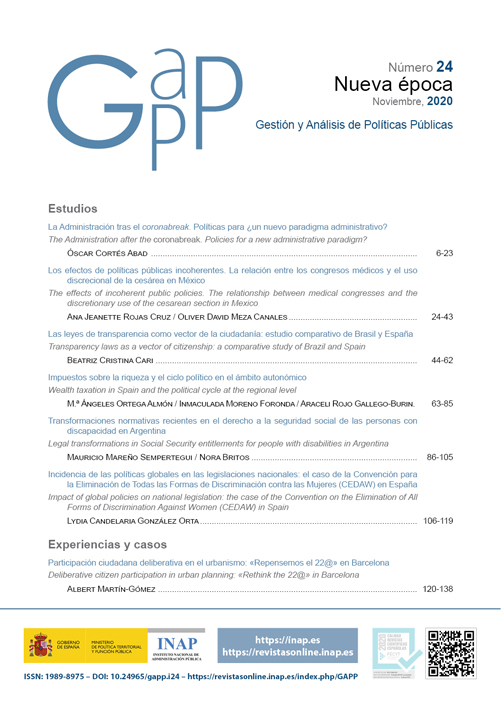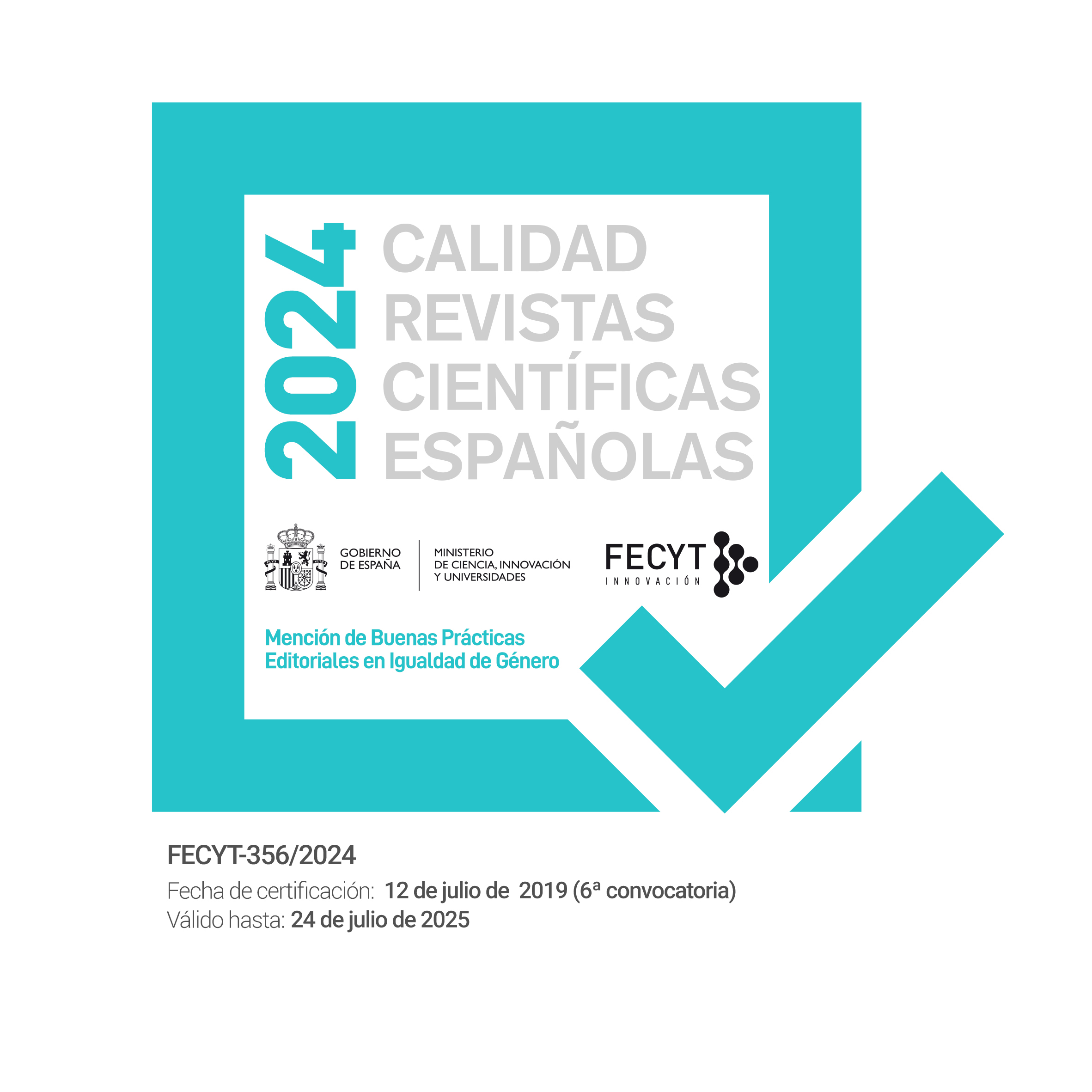Los efectos de políticas públicas incoherentes. La relación entre los congresos médicos y el uso discrecional de la cesárea en México
DOI:
https://doi.org/10.24965/gapp.i24.10792Palabras clave:
Políticas públicas, coherencia de política, diseño de políticas, práctica de cesáreas, regresión múltipleResumen
En esta investigación discutimos la importancia que tiene poner énfasis en las políticas públicas que son incoherentes entre sí, en materia de eficacia del Estado. Utilizamos el caso de la práctica de la cesárea en México para entender cómo el fenómeno puede parcialmente explicarse a partir de la incoherencia entre instrumentos de la política de salud del gobierno mexicano. Preguntamos ¿hasta qué punto la realización de congresos médicos de ginecología y obstetricia, como parte de un proceso de certificación médica, se relaciona con la práctica de la cesárea en México, en el marco de una política pública que intenta acotar el uso discrecional de este método? Sostenemos que los objetivos de una política se ven afectadas por los instrumentos de otra política, y que por tanto el uso discrecional de este método de nacimiento está asociado por la incoherencia experimentada a partir de la presencia física que exige la certificación mediante congresos. Para demostrarlo se calculó la tasa de cesáreas por día de los años 2008 a 2015, y rastreamos las fechas de los congresos nacionales de ginecología y obstetricia para el mismo periodo de tiempo. Determinamos la asociación estadística entre ambos sucesos a partir de un análisis de regresión múltiple. El resultado es que existe una asociación estadística entre la tasa y la existencia de los congresos soportando el argumento de la incoherencia. En las conclusiones se proponen algunas ideas de política para mitigar este problema en lo particular, y en general en atender la incoherencia entre políticas del Estado.
Descargas
Citas
AGUILAR, L. F. (2009): “Marco para el análisis de las políticas públicas”, en MARIÑEZ, F. y GARZA, V. (coords.): Política pública y democracia en América Latina: Del análisis a la implementación, págs. 11-33. México: Miguel Ángel Porrúa.
BELTRÁN, A. P.; YE, J.; MOLLER, A.-B.; ZHANG, J.; GÜLMEZOGLU, A. M.; TORLONI, M.ª R. (2016): “The Increasing Trend in Caesarean Section Rates: Global, Regional and National Estimates: 1990-2014”, en PLoS ONE, vol. 11, núm. 2, e0148343. DOI: https://doi.org/10.1371/journal.pone.0148343.
BERNAL-GARCÍA C.; NAHÍN-ESCOBEDO, C. C. (2018): “Cesárea: situación actual y factores asociados en México”, en Salud Quintana Roo, vol. 11, núm. 40, págs. 28-33. URL: https://www.medigraphic.com/cgi-bin/new/resumen.cgi?IDARTICULO=92469.
BLOUIN, C. (2007): “Trade Policy and Health: From Conflicting Interests to Policy Coherence”, en Bulletin of the World Health Organization, vol. 85, núm. 3, págs. 169-173. DOI: https://doi.org/10.2471/blt.06.037413.
BURNS, L. R.; GELLER, S. E.; WHOLEY, D. R. (1995): “The effect of physician factors on the caesarean decision”, en Medical Care, vol. 33, núm. 4, págs. 365-382. https://doi.org/10.1097/00005650-199504000-00004.
CEJUDO, G. M.; MICHEL, C. L. (2015): “Resolviendo problemas sociales complejos mediante la integración de políticas. El caso de la Cruzada Nacional contra el Hambre en México”, en Revista del CLAD Reforma y Democracia, núm. 63, págs. 33-64. URL: http://old.clad.org/portal/publicaciones-del-clad/revista-clad-reforma-democracia/articulos/063-octubre-2015/Cejudo.pdf.
CEJUDO, G. M.; MICHEL, C. L. (2017): “Addressing fragmented government action: coordination, coherence, and integration”, en Policy Sciences, vol. 50, págs. 745-767. DOI: https://doi.org/10.1007/s11077-017-9281-5.
CEJUDO, G. M.; MICHEL, C. L. (2016): “Coherencia y Políticas Públicas. Metas, instrumentos y poblaciones objetivo”, en Gestión y Política Pública, vol. 25, núm. 1, págs. 3-31. DOI: http://dx.doi.org/10.29265/gypp.v25i1.149.
CHRISTENSEN, T.; LÆGREID, P. (2008): “The Challenge of Coordination in Central Government Organizations: the Norwegian Case”, en Public Organization Review, vol. 8, núm. 2, págs. 97-116. DOI: https://doi.org/10.1007/s11115-008-0058-3.
CROWLEY, K.; HEAD, B. W. (2017): “The enduring challenge of «wicked problems»: revisiting Rittel and Webber”, en Policy Sciences, vol. 50, núm. 4, págs. 539-547. DOI: https://doi.org/10.1007/s11077-017-9302-4.
COMITÉ NORMATIVO NACIONAL DE CONSEJOS DE ESPECIALIDADES MÉDICAS A. C. (CONACEM) (2017): Reglamento de Idoneidad. Revisado en septiembre 2017. URL: https://conacem.org.mx/index.php/marco-juridico/reglamento.
CONSEJO MEXICANO DE GINECOLOGÍA Y OBSTETRICIA A. C. (CMGO) (2017): Estatutos de la Asociación. Revisado en septiembre 2017. URL: https://cmgo.org.mx/assets/estatutos_cmgo_2020.pdf.
CONSEJO MEXICANO DE GINECOLOGÍA Y OBSTETRICIA A. C. (CMGO) (2017): Examen de certificación. Revisado en septiembre 2017. URL: https://www.cmgo.org.mx/certificacion.html.
CONSEJO MEXICANO DE GINECOLOGÍA Y OBSTETRICIA A. C. (CMGO) (2017): Cedula de Vigencia de Certificación. Revisado en septiembre 2017. URL: https://cmgo.org.mx/assets/cedula_vigencia_certificacion_2019.pdf.
ESTADOS UNIDOS MEXICANOS (2015): “Acuerdo por el que se emiten los Lineamientos a los que se sujetarán el Comité Normativo Nacional de Consejos de Especialidades Médicas y los Consejos de Especialidades Médicas a los que se refiere el art. 81 de la Ley General de Salud”, en Diario Oficial de la Federación, 25 de marzo de 2015. Revisado en enero 2018. URL: https://www.dof.gob.mx/nota_detalle.php?codigo=5386686&fecha=25/03/2015.
DIRECCIÓN GENERAL DE INFORMACIÓN EN SALUD DE MÉXICO (2017): Datos Abiertos-Nacimientos. Revisado en julio 2017. URL: http://www.dgis.salud.gob.mx/contenidos/basesdedatos/da_nacimientos_gobmx.html.
ELIZALDE GONZÁLEZ, J. J. (2017): “Congresos médicos. La importancia de participar”, en Medicina Crítica, vol. 31, núm. 6, págs. 318-319. URL: https://www.medigraphic.com/pdfs/medcri/ti-2017/ti176a.pdf.
FEDERACIÓN MEXICANA DE COLEGIOS DE OBSTETRICIA Y GINECOLOGÍA A. C. (FEMECOG) (2017): Inicio. Revisado en septiembre 2017. URL: https://femecog.org.mx/.
GONZÁLEZ-PÉREZ, G. J.; GUADALUPE VEGA, M.ª; CABRERA, C. (2011): “Factores socio epidemiológicos y de la organización de los servicios de salud asociados a la operación cesárea”, en GONZÁLEZ-PÉREZ, G. J.; GUADALUPE VEGA, M.ª; CABRERA, C.: Cesáreas en México: aspectos sociales, económicos y epidemiológicos. México: Universidad de Guadalajara.
HEAD, B. W.; ALFORD, J. (2013): “Wicked Problems: Implications for Public Policy and Management”, en Administration & Society, vol. 47, núm. 6, págs. 711-739. DOI: https://doi.org/10.1177/0095399713481601.
HOWLETT, M.; RAYNER, J. (2007): “Design Principles for Policy Mixes: Cohesion and Coherence in «New Governance Arrangements»”, en Policy and Society, vol. 26, núm. 4, págs. 1-18. https://doi.org/10.1016/s1449-4035(07)70118-2.
HURST, M. y SUMMEY, P. (1984): “Childbirth and social class: The case cesarean delivery”, en Social Science and Medicine, vol. 18, núm. 8, págs. 621-631. https://doi.org/10.1016/0277-9536(84)90290-9.
INSTITUTO NACIONAL DE GEOGRAFÍA Y ESTADÍSTICA (INEGI) (2018): Comunicado de Prensa núm. 244/19 de la Encuesta Nacional de la Dinámica Demográfica (ENADID) 2018. Revisado en mayo 2019. URL: https://www.inegi.org.mx/contenidos/saladeprensa/boletines/2019/EstSociodemo/ENADID2018.pdf.
MUÑOZ-ENCISO J. M.; ROSALES-AUJANG, E.; DOMÍNGUEZ-PONCE, G.; SERRANO-DÍAZ C. (2011): “Operación cesárea: ¿Indicación justificante o preocupación justificada?”, en Ginecología y Obstetricia de México, vol. 79, núm. 2, págs. 67-74. URL: https://www.medigraphic.com/cgi-bin/new/resumen.cgi?IDARTICULO=28187.
JUÁREZ, J. (2017): “Una epidemia de cesáreas innecesarias en México”, en The New York Times. Consultado en septiembre 2017. URL: https://www.nytimes.com/es/2017/08/28/una-epidemia-de-cesareas-innecesarias-en-mexico/?smid=tw-share-es.
MAY, P. J.; SAPOTICHNE, J.; WORKMAN, S. (2006): “Policy Coherence and Policy Domains”, en The Policy Studies Journal, vol. 34, núm. 3, págs. 381-403. DOI: https://doi.org/10.1111/j.1541-0072.2006.00178.x.
MEZA, O. (2018): “Del plato a la boca se cae la sopa: evaluación de la consistencia en las intervenciones públicas subnacionales”, en BALLEZCÁ, M. (ed.): Evaluación de Políticas Subnacionales en México: Evalúa Jalisco, págs. 287-309. Guadalajara: Gobierno de Jalisco y Colegio de Jalisco.
MEZA, O.; GUERRA E.; CORONA, G. (2018): “Las Políticas de Drogas y el Estado: Una aproximación para una política de mitigación de riesgos”, en Boletim de Análise Político-Institucional Diciembre, núm. 18, págs. 19-29.
NEWMAN, J.; HEAD, B. W. (2017): “Wicked tendencies in policy problems: Rethinking the distinction between social and technical problems”, en Policy and Society, vol. 36, núm. 3, págs. 414-429. DOI: https://doi.org/10.1080/14494035.2017.1361635.
ORGANIZACIÓN MUNDIAL DE LA SALUD Y HUMAN REPRODUCTIVE PROGRAMME (2015): Declaración de la OMS sobre la tasa de cesáreas. Resumen ejecutivo. Revisado en septiembre 2017. URL: http://www.who.int/reproductivehealth/publications/maternal_perinatal_health/cs-statement/es/.
PETERS, G. B. (1998): “Managing Horizontal Government: The Politics of Coordination”, en Public Administration, vol. 76, núm. 1, págs. 295-311. DOI: https://doi.org/10.1111/1467-9299.00102.
PETERS, G. B. (2004): The Search for Coordination and Coherence in Public Policy: Return to the Center? Pittsburgh: University of Pittsburgh.
POLLIT, C. (2003): “Joined up government: a survey”, en Political Studies Review, vol. 1, núm. 1, págs. 34-49. https://doi.org/10.1111/1478-9299.00004.
RITTEL, H. W. J.; WEBBER. M. M. (1973): “Dilemmas in a general theory of planning”, en Policy Sciences, vol. 4, núm. 1.973, págs. 155-169. https://doi.org/10.1007/BF01405730.
SANDALL, J.; TRIBE, R.; AVERY, L.; MOLA, G.; VISSER, G.; HOMER, C.; GIBBONS, D.; KELLY, N.; POWELL, H.; KIDANTO, H.; TAYLOR, P.; TEMMERMAN, M. (2018): “Short-term and long term effects of caesarean section on the health of women and children”, en The Lancet, vol. 392, núm. 10.155, págs. 1.349-1.357. https://doi.org/10.1016/S0140-6736(18)31930-5.
SECRETARÍA DE SALUD (SSA) (2002): Cesárea segura. Lineamiento técnico. Revisado en septiembre 2017. URL: http://www.salud.gob.mx/unidades/cdi/documentos/DOCSAL7101.pdf.
STEAD, D. (2008): “Institutional aspects of integrating transport, environment and healt policies”, en Transport Policy, vol. 15, núm. 3, págs. 139-148. https://doi.org/10.1016/j.tranpol.2007.12.001.
TUSSING, A. D.; WOJTOWICZ, M. A. (1993): “The effect of physician characteristics on clinical behavior: Cesarean section in New York State”, en Social Science and Medicine, vol. 37, núm. 10, págs. 1.251-1.260. https://doi.org/10.1016/0277-9536(93)90336-3.
VALLEJOS-PARÁS A.; ESPINO-Y-SOSA, S.; RUIZ-SÁNCHEZ, J.; DURÁN-ARENAS, L. (2011): “Tendencias y factores asociados a cesáreas en México: validación de un instrumento”, en Perinatología y Reproducción Humana, vol. 25, núm. 4, págs. 212-218.
WOLPERT, E. (2017): “La certificación médica”, en Memoria simposio CONAMED. La Constitución y la Salud, vol. 5, núm. 5, págs. 1-14.
WOOLDRIDGE, J. M. (2009): “Análisis de regresión múltiple”, en WOOLDRIDGE, J. M. (coord.): Introducción a la econometría. Un enfoque moderno, págs. 73-112. México: Cengage Learning.
Descargas
Publicado
Cómo citar
Número
Sección
Licencia
Derechos de autor 2020 Gestión y Análisis de Políticas Públicas

Esta obra está bajo una licencia internacional Creative Commons Atribución-NoComercial 4.0.












